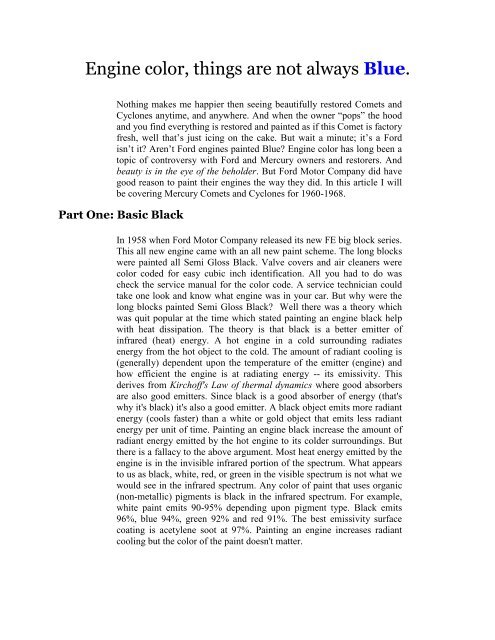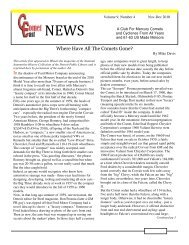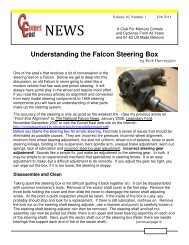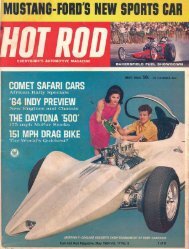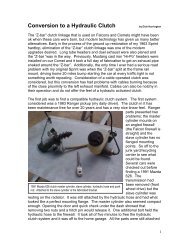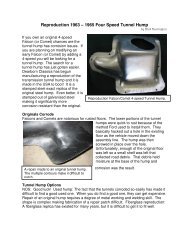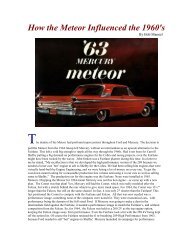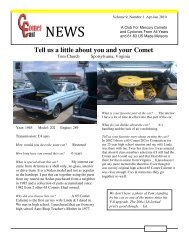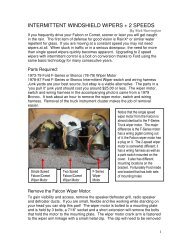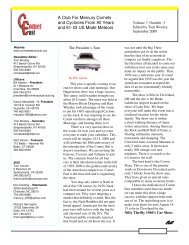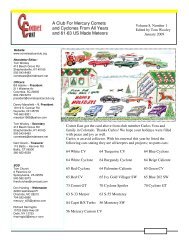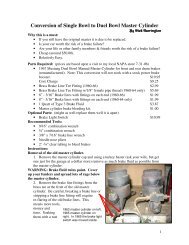Engine color, things are not always Blue. - Comet East
Engine color, things are not always Blue. - Comet East
Engine color, things are not always Blue. - Comet East
You also want an ePaper? Increase the reach of your titles
YUMPU automatically turns print PDFs into web optimized ePapers that Google loves.
<strong>Engine</strong> <strong>color</strong>, <strong>things</strong> <strong>are</strong> <strong>not</strong> <strong>always</strong> <strong>Blue</strong>.<br />
Nothing makes me happier then seeing beautifully restored <strong>Comet</strong>s and<br />
Cyclones anytime, and anywhere. And when the owner “pops” the hood<br />
and you find everything is restored and painted as if this <strong>Comet</strong> is factory<br />
fresh, well that’s just icing on the cake. But wait a minute; it’s a Ford<br />
isn’t it? Aren’t Ford engines painted <strong>Blue</strong>? <strong>Engine</strong> <strong>color</strong> has long been a<br />
topic of controversy with Ford and Mercury owners and restorers. And<br />
beauty is in the eye of the beholder. But Ford Motor Company did have<br />
good reason to paint their engines the way they did. In this article I will<br />
be covering Mercury <strong>Comet</strong>s and Cyclones for 1960-1968.<br />
Part One: Basic Black<br />
In 1958 when Ford Motor Company released its new FE big block series.<br />
This all new engine came with an all new paint scheme. The long blocks<br />
were painted all Semi Gloss Black. Valve covers and air cleaners were<br />
<strong>color</strong> coded for easy cubic inch identification. All you had to do was<br />
check the service manual for the <strong>color</strong> code. A service technician could<br />
take one look and know what engine was in your car. But why were the<br />
long blocks painted Semi Gloss Black? Well there was a theory which<br />
was quit popular at the time which stated painting an engine black help<br />
with heat dissipation. The theory is that black is a better emitter of<br />
infr<strong>are</strong>d (heat) energy. A hot engine in a cold surrounding radiates<br />
energy from the hot object to the cold. The amount of radiant cooling is<br />
(generally) dependent upon the temperature of the emitter (engine) and<br />
how efficient the engine is at radiating energy -- its emissivity. This<br />
derives from Kirchoff's Law of thermal dynamics where good absorbers<br />
<strong>are</strong> also good emitters. Since black is a good absorber of energy (that's<br />
why it's black) it's also a good emitter. A black object emits more radiant<br />
energy (cools faster) than a white or gold object that emits less radiant<br />
energy per unit of time. Painting an engine black increase the amount of<br />
radiant energy emitted by the hot engine to its colder surroundings. But<br />
there is a fallacy to the above argument. Most heat energy emitted by the<br />
engine is in the invisible infr<strong>are</strong>d portion of the spectrum. What appears<br />
to us as black, white, red, or green in the visible spectrum is <strong>not</strong> what we<br />
would see in the infr<strong>are</strong>d spectrum. Any <strong>color</strong> of paint that uses organic<br />
(non-metallic) pigments is black in the infr<strong>are</strong>d spectrum. For example,<br />
white paint emits 90-95% depending upon pigment type. Black emits<br />
96%, blue 94%, green 92% and red 91%. The best emissivity surface<br />
coating is acetylene soot at 97%. Painting an engine increases radiant<br />
cooling but the <strong>color</strong> of the paint doesn't matter.
Part Two: Color my World<br />
All Mercury and <strong>Comet</strong> passenger cars 1960 through the 1965 long<br />
blocks were painter Semi Gloss Black when new. The long block<br />
includes engine block, intake manifold, cylinder heads, oil pan, and<br />
water pump.<br />
One thing you need to know when you <strong>are</strong> painting any Mercury or<br />
<strong>Comet</strong> engine is this. When the engine is assembled on the engine line,<br />
the valve covers <strong>are</strong> painted separate from the engine. When the valve<br />
covers <strong>are</strong> installed, the attaching bolts <strong>are</strong> left unpainted. In fact the<br />
majority of bolts attaching items to the engine <strong>are</strong> left unpainted when<br />
new. Author Bob Mannel in his book, Mustang & Ford Small Block V8<br />
1962 – 1969, list all engine items which <strong>are</strong> painted and which <strong>are</strong> left<br />
unpainted on Ford small block engines. From what I have read and seen,<br />
the same scheme holds true for six cylinder engines. This is one simple<br />
visual that does make a big difference. It’s quit common to see this detail<br />
overlooked.<br />
For 1960 <strong>things</strong> were simple for the all new <strong>Comet</strong> with only the 144 cid<br />
six cylinder engine. The valve cover and air cleans were painted yellow,<br />
Ditzler Paint code 81196. The oil breather caps were painted Semi Gloss<br />
Black with the proper decals installed as shown in the pictures below.<br />
The examples to left <strong>are</strong> 144 cubic inch<br />
engines in the correct<br />
yellow <strong>color</strong>. All 144 engines form 1960<br />
thru 1963 were painted as above.<br />
The 144 engine <strong>color</strong> scheme was unchanged for its entire run from 1960<br />
thru 1963. This is <strong>not</strong> the same yellow use on <strong>Comet</strong> engines in later<br />
years. In 1961 the optional 170 cid engine was added to the <strong>Comet</strong><br />
lineup. This new additions paint scheme differed from the 144, with its<br />
valve cover and air cleaner being painter Argent, which is a version of<br />
Silver. All 170 cid engines installed in <strong>Comet</strong>s from 1961 thru 1964 used<br />
this paint scheme. Ditzler Paint code for these engines is DEE-45
Examples of 170 cubic inch paint scheme 1961 thru 1964<br />
With the introduction of the 260 Cyclone V8 to the 1963 mid-year <strong>Comet</strong> lineup,<br />
<strong>Comet</strong> now had more muscle then every before. This all new power plant<br />
was the first of a long line of V8 power that would be installed in <strong>Comet</strong>s to<br />
come. The 260 Cyclone V8 can be identified by its red valve covers and air<br />
cleaner. This <strong>color</strong> was NOT Ford Red. It is very close to Chevrolet Orange-Red<br />
Dupli<strong>color</strong> DE 1607, or 1970 Mercury “Competition Orange Ditzler Paint<br />
00449. The air cleaner snorkel and heat collector <strong>are</strong> painted Semi Gloss Black.<br />
Below <strong>are</strong> some examples of the 260 Cyclone V8.<br />
The above examples <strong>are</strong> a 260 Cyclone V8. You can clearly see the special<br />
Orange/Red <strong>color</strong> scheme. Also the snorkel and heat collector can be seen<br />
in semi gloss black. Oil filler cap should be semi gloss black also.
1964 brought major changes to the <strong>Comet</strong> line-up with all new sheet metal and<br />
a major facelift. <strong>Comet</strong> also received two new engines. The six cylinder lineup<br />
was given a new 200 cubic inch engine and the 144 was dropped. The V8<br />
line-up was given a new optional 289-4V and retained the 260 Cyclone V8 as<br />
well. Early cars built with 260 engines use a light blue <strong>color</strong> scheme for valve<br />
covers and air cleaner. A very good match would me 1970 Ford Grabber <strong>Blue</strong>.<br />
They were NOT painted Ford Corporate <strong>Blue</strong>. The Ditzler Paint code for this<br />
engine is 11297.<br />
The new 200 cubic inch six was given an ivory white valve cover and air<br />
cleaner. The Ditzler Paint code for both is 81052. The 289 V8 was given Gold<br />
Bronze valve covers and air cleaner for all models except the Cyclone. As with<br />
the 260 V8s the snorkel and heat collector <strong>are</strong> painted Semi Gloss Black. The<br />
Ditzler paint code for the 289 V8 valve covers and air cleaner is 22362. In<br />
January 1964 a sporty <strong>Comet</strong> Cyclone model was added to the model line-up.<br />
The Cyclones were given its own unique Argent paint scheme for its air<br />
cleaner. The Ditzler Paint code for this engine is DEE-45 just like the 170 six<br />
cylinder. Cyclone 289 4v engine were also given an optional engine dress-up<br />
kit which included chrome valve covers, dipstick, and air cleaner top cover as<br />
standard. Below <strong>are</strong> some examples from the 1964 model year.<br />
1964 289-V8 in Bronze Gold and all new 200 six cylinder in Ivory White paint scheme.<br />
The 1965 model year brought major changes to the <strong>Comet</strong> line-up for a second<br />
year. Once again <strong>Comet</strong> received a major facelift. With new sheet metal and<br />
new overall look front and rear. The 170 six cylinder engine was dropped from<br />
US production vehicles. And an all new 200 cubic inch six cylinder engine<br />
was added to the line-up. For the V8 buyer the 260 V8 was dropped, and the<br />
289 was upgraded to 200 horsepower and 225 horsepower versions. The Color<br />
scheme changed for 1965 as well. All engines except for the engines install in<br />
the Cyclone models used a Bright Yellow <strong>color</strong> scheme for the valve covers<br />
and air cleaners. This is a brighter yellow then used on the earlier 144 engines.<br />
The Ditzler paint code number is 80301. I personally used Plasti-Kote “Brite-<br />
Yellow” paint code 376 on my 65 <strong>Comet</strong>. Everyone has told me it is totally<br />
correct. The snorkel and heat collector <strong>are</strong> painted Semi Gloss Black as they
were from the 64 model year.. The Cyclones for 1965 were once again given<br />
its own unique Argent paint scheme for its air cleaner. The Ditzler Paint code<br />
for this engine again was DEE-45 just like the 1964 models. Cyclone Super<br />
289 engines were also given the optional engine dress-up kit as standard and<br />
including chrome valve covers, dipstick, and air cleaner top cover. Below <strong>are</strong><br />
some examples for the 1965 model year.<br />
Above <strong>are</strong> examples of the 1965 <strong>Comet</strong> and Cyclone <strong>Engine</strong>s. Notice the Cyclone far right is painted<br />
In its unique Argent paint scheme.<br />
If it is blue, it is power by Ford.<br />
For many years prior to 1966, as we have seen, Ford engines were <strong>color</strong>-keyed to specific<br />
applications and carlines. Starting in 1966, this practice changed. All engine now were painted<br />
Ford Corporate <strong>Blue</strong>. Instead of <strong>color</strong>-keyed valve covers and air cleaners, the entire engine<br />
would be Ford Corporate <strong>Blue</strong>, like the Ford <strong>Blue</strong> Oval and the Ford <strong>Blue</strong> offset dealer signs<br />
popping up in 1966 at Ford dealerships. Ford's message for 1966 and beyond was simple--if it is<br />
blue, it is power by Ford.<br />
As in earlier years, Ford continued to paint the valve covers separate from the engines. <strong>Engine</strong><br />
long-blocks, which included block, intake manifold, heads, and oil pan, were all painted Ford<br />
<strong>Blue</strong>. Valve covers were installed toward the end of engine assembly using natural metal bolts<br />
with integral lock washers. We've learned through observation and conversation with restorers<br />
that Dupli<strong>color</strong>'s Dark Ford <strong>Blue</strong> (1606) is an accepted <strong>color</strong> for '66 and later Ford engine<br />
restorations. An alternative, when Dupli<strong>color</strong> isn't available, is Krylon's Dark Ford<strong>Blue</strong>, which is<br />
also the correct shade of dark blue. Plastikote is a<strong>not</strong>her paint brand, Royal <strong>Blue</strong> (1134) an<br />
acceptable <strong>color</strong> for '66 and later. Below is the ad from Ford Motor Company which ran in<br />
Sunset Magazine in January 1966.
So the next time you “pop” the hood on a beautiful <strong>Comet</strong> or Cyclone at the local car show<br />
remember, there is more to a beautiful engine then just paint.


